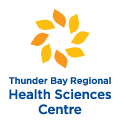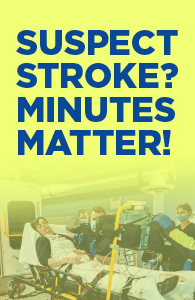June is Stroke Month – How Organized Stroke Care and your Regional Teams are Saving Lives!

Since 2005, implementation of an organized system of stroke care delivery in Ontario was associated with both improved patient outcomes after stroke and as well as improved processes of care1. With organized stroke care, the following changes were seen: increased rates of care received at stroke centers and on stroke units, decreased rates of discharge to long-term care and decreased 30-day mortality for patients with stroke. The implementation of the Ontario Stroke System was also associated with an increased proportion of patients who received thrombolytic therapy, the “clot busting” acute stroke treatment.
In Northwestern Ontario, regional stroke care is organized to include many partners and programs.
- The Regional Stroke Center for Northwestern Ontario is located at Thunder Bay Regional Health Sciences Centre (TBRHSC). The Regional Stroke Centre has implemented a “Code Stroke” process that immediately activates a large clinical team to assess and deliver acute stroke treatments to eligible patients.
TBRHSC hosts the following regional stroke services:
- The Northwestern Ontario Regional Stroke Network is part of the Ontario Stroke System and one of 11 regional stroke networks in the province. The Network’s vision for Northwestern Ontario is “Fewer strokes. Better outcomes.” and its mission is “To continuously improve stroke prevention, care, recovery and re-integration”.
- The 12-bed Regional Stroke Unit, located on 2C, has a team of doctors, nurses and therapists specialized in the assessment and management of acute stroke that provide care for people with stroke and their families.
- The Secondary Stroke Prevention Clinic addresses stroke prevention in a coordinated and interprofessional manner. The team consists of neurologists, a nurse practitioner and a dietitian who focus on determining the possible causes of TIA or stroke. In addition, the team educates patients regarding lifestyle changes to help modify their risk factors for stroke.
- The Telestroke program provides patients with stroke living in more remote areas of the region access to 24/7 life-saving emergency care. Emergency Physicians use the Ontario Telemedicine Network to connect with Ontario stroke neurologists to obtain urgent diagnosis and treatment advice, including the administration of the time-sensitive “clot busting” drug tPA. Telestroke services are available at La Verendrye General Hospital in Fort Frances, Lake of the Woods District Hospital in Kenora, Dryden Regional Health Center in Dryden and Meno Ya Win Health Centre in Sioux Lookout.
- The Regional Stroke Rehabilitation inpatient and outpatient services are located at St. Joseph’s Hospital in Thunder Bay. Inpatient stroke care is delivered on the Special Rehabilitation Service (3 North) by a team of doctors, nurses and therapists Both inpatient and outpatient programs provide specialized stroke rehabilitation and deliver client-centered care for people with stroke and their families. Also offered throughout Northwestern Ontario via videoconferencing are the Moving on After Stroke Program, a 9-week, 18 session self-management, exercise and support program, and the Regional Tele-SLP program providing speech and language services for patients with stroke.
- The Community Stroke Prevention Clinics staffed by Registered Nurses, see patients with stroke and TIA to monitor risk factors and assist with lifestyle strategies to prevent reoccurrence. The Clinics are located at La Verendrye General Hospital in Fort Frances, Lake of the Woods District Hospital in Kenora, Wilson Memorial General Hospital in Marathon and Meno Ya Win Health Centre in Sioux Lookout.
Stay tuned for future articles coming this month to highlight other regional stroke care initiatives that support people experiencing a stroke to recognize, react, respond and recover.
For more information, visit our website at www.nwostroke.ca or contact Meaghan Sharp, Director, Cardiovascular and Stroke Program, Thunder Bay Regional Health Sciences Centre at 807-684-6796 or sharpme@tbh.net.
Reference:
- Kapral MK et al. (2013) Effect of a provincial system of stroke care delivery on stroke care and outcomes. CMAJ. Vol. 185, No. 10.






